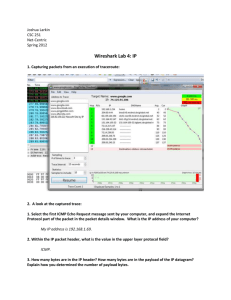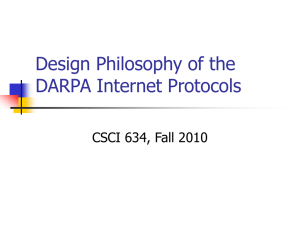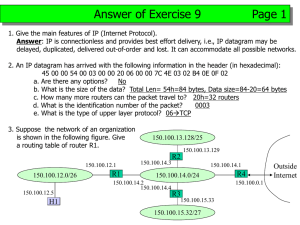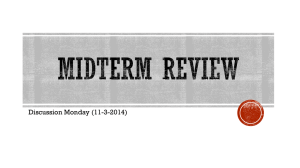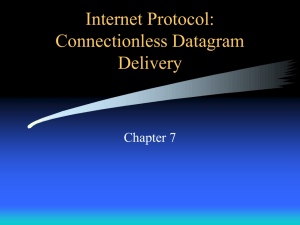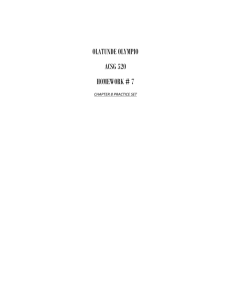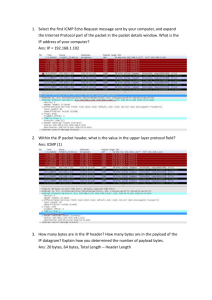Document
advertisement
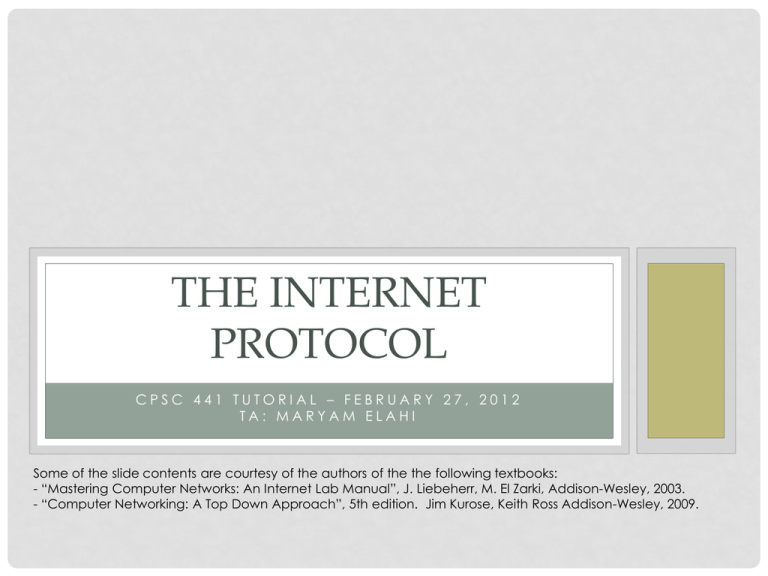
THE INTERNET PROTOCOL CPSC 441 TUTORIAL – FEBRUARY 27, 2012 TA: MARYAM ELAHI Some of the slide contents are courtesy of the authors of the the following textbooks: - “Mastering Computer Networks: An Internet Lab Manual”, J. Liebeherr, M. El Zarki, Addison-Wesley, 2003. - “Computer Networking: A Top Down Approach”, 5th edition. Jim Kurose, Keith Ross Addison-Wesley, 2009. THE NETWORK LAYER • IP (Internet Protocol) is a Network Layer Protocol. • RFC 791 provides the specification for IP. application transport network 1. Send data data link physical application transport 2. Receive data network data link physical Network Layer 2 IP: THE WAIST OF THE HOURGLASS • IP is the waist of the hourglass of the Internet protocol stack. • Multiple higher-layer protocols • Multiple lower-layer protocols • One common protocol at the network layer for data transmission. Applications HTTP FTP SMTP TCP UDP IP Data link layer protocols Physical layer protocols 3 HIGHEST LAYER IN ROUTERS • IP is the highest layer protocol which is implemented at both routers and hosts Application Application protocol Application TCP TCP protocol TCP IP Data Link Host IP IP protocol Data Link Data Link IP IP protocol Data Link Router Data Link Data Link IP protocol Data Link Router Data Link IP Network Access Host 4 BEST EFFORT PROTOCOL • IP provides an unreliable connectionless best effort service (also called: “datagram service”). • Unreliable: no guarantee for delivery of packets • Connectionless: Each packet (“datagram”) is handled independently. IP is not aware that packets between hosts may be sent in a logical sequence • Best effort: IP does not make guarantees on the service (no throughput guarantee, no delay guarantee, etc.) • Consequences: Higher layer protocols have to take care of delivery guarantees. 5 IP DATAGRAM bit # 0 7 8 version header length 15 16 ECN DS Identification time-to-live (TTL) 23 24 31 total length (in bytes) 0 D M F F protocol Fragment offset header checksum source IP address destination IP address options (0 to 40 bytes) payload 4 bytes • Header Size: at least 20 bytes and at most 60 bytes (with options) • Total Length: at most 216 bytes = 65536 bytes 6 IP VERSION • The first publicly used version of the Internet Protocol was version 4 (IPv4) • Address space: 32 bits, (approximately 4.3 billion addresses) • Initially it was thought to be enough! • Address exhaustion • On February 3, 2011, the Internet Assigned Numbers Authority (IANA) officially depleted the global pool of completely fresh blocks of addresses. • The address exhaustion was a concern as early as 1990s. • IPv6 is the next generation IP that tries to address the shortcomings of IPv4 • Has 128 bits address space • Designed to live alongside IPv4 7 WHAT ABOUT VERSION 5? • It doesn't exist. It is in fact intentionally skipped to avoid confusion, or at least to rectify it. • IP version 5 relates to an experimental TCP/IP protocol called the Internet Stream Protocol, Version 2, originally defined in RFC 1190. • This protocol was originally seen by some as being a peer of IP at the Internet Layer in the TCP/IP architecture, and in its standard, these packets were assigned IP version 5 to differentiate them from “normal” IP packets (version 4). • This protocol apparently never went anywhere, but to be absolutely sure that there would be no confusion, version 5 was skipped over in favor of version 6. 8 A BIT OF HISTORY “The decision to put a 32-bit address space on there was the result of a year's battle among a bunch of engineers who couldn't make up their minds about 32, 128, or variable-length. And after a year of fighting, I said--I'm now at ARPA, I'm running the program, I'm paying for this stuff, I'm using American tax dollars, and I wanted some progress because we didn't know if this was going to work. So I said: OK, it's 32-bits. That's enough for an experiment; it's 4.3 billion terminations. Even the Defense Department doesn't need 4.3 billion of everything and couldn't afford to buy 4.3 billion edge devices to do a test anyway. So at the time I thought we were doing an experiment to prove the technology and that if it worked we'd have opportunity to do a production version of it. Well, it just escaped! It got out and people started to use it, and then it became a commercial thing. So this [IPv6] is the production attempt at making the network scalable.” -- Vint Cerf, one of the “fathers of the Internet”. (From: Google IPv6 Conference 2008) 9 IP DATAGRAM FIELDS bit # 0 7 8 version header length 15 16 ECN DS Identification time-to-live (TTL) 23 24 31 total length (in bytes) 0 D M F F protocol Fragment offset header checksum source IP address destination IP address options (0 to 40 bytes) payload 4 bytes • Version (4 bits): current version is 4, next version will be 6. • Header length (4 bits): length of IP header, in multiples of 4 bytes • DS: Type of service, or type of data (used to specify priority or request low-delay routes) 10 IP DATAGRAM FIELDS bit # 0 7 8 version header length 15 16 ECN DS Identification time-to-live (TTL) 23 24 31 total length (in bytes) 0 D M F F protocol Fragment offset header checksum source IP address destination IP address options (0 to 40 bytes) payload 4 bytes • Identification (16 bits): Unique identification of a datagram from a host. Incremented whenever a datagram is transmitted 11 TIME TO LIVE • Time To Live (TTL) (1 byte): • Specifies longest paths before datagram is dropped • Role of TTL field: Ensure that packet is eventually dropped when a routing loop occurs Used as follows: • Sender sets the value (e.g., 64) • Each router decrements the value by 1 • When the value reaches 0, the datagram is dropped 12 IP DATAGRAM FIELDS bit # 0 7 8 version header length 15 16 ECN DS Identification time-to-live (TTL) 23 24 31 total length (in bytes) 0 D M F F protocol Fragment offset header checksum source IP address destination IP address options (0 to 40 bytes) payload 4 bytes • Protocol (1 byte): Specifies the higher-layer protocol (e.g. TCP and UDP) for demultiplexing. • Header checksum (2 bytes): A simple 16-bit long checksum of the header 13 THE REST • Source and Destination IPs • Options: • Security restrictions • Record Route: each router that processes the packet adds its IP address to the header. • Timestamp: each router that processes the packet adds its IP address and time to the header. • (loose) Source Routing: specifies a list of routers that must be traversed. • (strict) Source Routing: specifies a list of the only routers that can be traversed. • Padding: Padding bytes are added to ensure that header ends on a 4-byte boundary 14 FRAGMENT FLAGS AND OFFSET bit # 0 7 8 version header length 15 16 ECN DS Identification time-to-live (TTL) 23 24 31 total length (in bytes) 0 D M F F protocol Fragment offset header checksum source IP address destination IP address options (0 to 40 bytes) payload 4 bytes • Flags (3 bits): First bit always set to 0, DF bit (Do not fragment), MF bit (More fragments) • Fragment offset: For fragmentation/reassembly 15 MAXIMUM TRANSMISSION UNIT • Maximum size of IP datagram is 65535, but the data link layer protocol generally imposes a limit that is much smaller • Example: • Ethernet frames have a maximum payload of 1500 bytes IP datagrams encapsulated in Ethernet frame cannot be longer than 1500 bytes • The limit on the maximum IP datagram size, imposed by the data link protocol is called maximum transmission unit (MTU) • MTUs for various data link protocols: -- Ethernet: -- 802.3: -- 802.5: 1500 1492 4464 -- FDDI: -- ATM AAL5: -- 802.11(WLAN): 4352 9180 2272 16 IP FRAGMENTATION • What if the size of an IP datagram exceeds the MTU? IP datagram is fragmented into smaller units. • What if the route contains networks with different MTUs? FDDI Ring Host A MTUs: FDDI: 4352 Ethernet Router Host B Ethernet: 1500 • Fragmentation: • IP router splits the datagram into several datagram • Fragments are reassembled at receiver 17 FRAGMENTATION / REASSEMBLY • Fragmentation can be done at the sender or at intermediate routers • The same datagram can be fragmented several times. • Reassembly of original datagram is only done at destination hosts !! IP datagram H Fragment 2 H2 Fragment 1 H1 Router 18 FIELDS USED FOR FRAGMENTATION • The following fields in the IP header are involved: version header length DS Identification time-to-live (TTL) protocol total length (in bytes) ECN 0 DM F F Fragment offset header checksum • Identification: When a datagram is fragmented, the identification is the same in all fragments • Flags: • DF bit is set: Should not fragment this Datagram, should be discarded if MTU is too small • MF bit set: This datagram is part of a fragment and an additional fragment follows this one • Fragment offset: Offset of the payload of this fragment in the original datagram • Total length: Total length of the current fragment 19 EXAMPLE OF FRAGMENTATION • A datagram of 4000B from a network of 4000 MTU to 1500 MTU length ID fragflag offset =4000 =x =0 =0 One large datagram becomes several smaller datagrams length ID fragflag offset =1500 =x =1 =0 length ID fragflag offset =1500 =x =1 =1480 length ID fragflag offset =1040 =x =0 =2960 20 RESOURCES • Slides from the book: “Mastering Computer Networks: An Internet Lab Manual”, J. Liebeherr, M. El Zarki, Addison-Wesley, 2003. • Slides from the book: “Computer Networking: A Top Down Approach”, 5th edition. Jim Kurose, Keith Ross AddisonWesley, 2009. • RFC 791 • http://tools.ietf.org/pdf/rfc791.pdf 21


